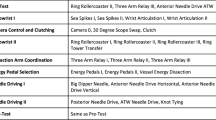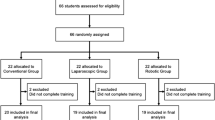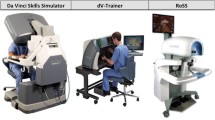Abstract
Background: The objective of this study was to compare the efficacy of the da Vinci robotic system using both the three-dimensional view (3D) and two-dimensional (2D) view options with traditional manually assisted laparoscopic techniques in performing standardized exercises. Methods: To evaluate surgical efficiency in the use of robotically assisted and manual laparoscopic surgery for standardized exercises six, last-year medical students without any surgical experience were selected. The exercises consisted of placing rings over receptacles, grasping a free hanging suture and cutting three pieces of it, running a suture, and performing a surgical knot. Each student performed the exercise twice. The median times needed for completion of the exercises and the median number of errors in performing the tasks were noted. Results: The unexperienced students performed the standardized tasks significantly quicker and with fewer errors when assisted by the da Vinci robot in the 3D optical display mode, as compared with traditional manually assisted laparoscopic surgery. Even when the 2D mode was selected, a significant advantage favoring the da Vinci robotic system was seen both in time and efficacy for most exercises. When the 3D and 2D modes were compared, time differences in favor of the 3D mode remained, but a significant difference in efficacy favoring the 3D mode was seen only in one exercise (exercise 2: suture cutting). Conclusions: The da Vinci robotic system permits standardized minimal invasive surgical exercises to be performed quicker and more efficiently than traditional minimally invasive techniques. Therefore, with the aid of this robotic system, difficult laparoscopic interventions may become easier to perform, and indications for minimal invasive surgery may be expanded.
Similar content being viewed by others
References
R Autsbach JF Onnasch V Falk T Walther M Kruger LO Schilling FW Mohr (2000) ArticleTitleThe Leipzig experience with robotic surgery. J Card Surg 15 82–87
GB Cadiere J Himpens M Vertruyen J Bruyns O Germany R Izizaw (2001) ArticleTitleEvaluation of telesurgical (robotic) Nissen fundoplication. Surg Endosc 15 918–923 Occurrence Handle1:STN:280:DC%2BD3MrlvVClug%3D%3D Occurrence Handle11605106
M Degueldre J Vandromme PT Huong GB Cadiere (2000) ArticleTitleRobotically assisted laparoscopic microsurgical tubal anastomosis: a feasibility study. Fertil Steril 74 1020–1023 Occurrence Handle10.1016/S0015-0282(00)01543-0 Occurrence Handle1:STN:280:DC%2BD3M%2Fkt12luw%3D%3D Occurrence Handle11056252
T Falcone JM Goldberg H Margossian L Stevens (2000) ArticleTitleRobotic assisted laparoscopic microsurgical tubal anastomosis: a human pilot study. Fertil Steril 73 1040–1042
A Garcia-Ruiz M Gagner JH Miller ChP Steiner J Hahn (1998) ArticleTitleManual vs robotically assisted laparoscopic surgery in the performance of basic manipulation and suturing tasks. Arch Surg 133 957–961 Occurrence Handle10.1001/archsurg.133.9.957 Occurrence Handle1:STN:280:DyaK1cvitVaktA%3D%3D Occurrence Handle9749847
P Lo N Ahmed RS Chung (2001) ArticleTitleWhich laparoscopic operations are the fastest growing in residency programs? Surg Endosc 15 IssueIDSuppl 1 SI45
J Marescaux MK Smith D Folscher F Jamali B Malassagne J Leroy (2001) ArticleTitleTelerobotic laparoscopic cholecystectomy: initial clinical experience with 25 patients. Ann Surg 234 1–7 Occurrence Handle10.1097/00000658-200107000-00001 Occurrence Handle1:STN:280:DC%2BD3MzlvFCisg%3D%3D Occurrence Handle11420476
D Nio WA Bemelman KT den Boer MS Dunker DJ Gouma TM van Gulik (2002) ArticleTitleEfficiency of manual vs robotical (Zeus) assisted laparoscopic surgery in the performance of standardized tasks. Surg Endosc 16 412–415 Occurrence Handle10.1007/s00464-001-9012-y Occurrence Handle1:STN:280:DC%2BD387psFSitg%3D%3D Occurrence Handle11928018
G Pasticier JB Rietbergen B Guillonneau G Fromont M Menom G Vallancien (2001) ArticleTitleRobotically assisted laparoscopic radical prostatectomy: feasibilty study in men. Eur Urol 40 70–74 Occurrence Handle10.1159/000049751 Occurrence Handle1:STN:280:DC%2BD3MvosFKqsw%3D%3D Occurrence Handle11528179
H Reichenspurner RJ Damiano M Mack DH Boehn H Gulbins C Detter B Meiser R Ellgas B Reichart (1999) ArticleTitleUse of the voice controlled and computer-assisted surgical system ZEUS for endoscopic coronary artery bypass grafting. J Thorac Cardiovasc Surg 118 11–16 Occurrence Handle1:STN:280:DyaK1MzhsF2ltg%3D%3D Occurrence Handle10384178
H Shennib . Bastawisy J McLoughlin F Moll (1999) ArticleTitleRobot computer-assisted telemanipulation enhances coronary artery bypass. J Thorac Cardiovasc Surg 117 3100–3103
Author information
Authors and Affiliations
Corresponding author
Rights and permissions
About this article
Cite this article
Hubens, G., Coveliers, H., Balliu, L. et al. A performance study comparing manual and robotically assisted laparoscopic surgery using the da Vinci system . Surg Endosc 17, 1595–1599 (2003). https://doi.org/10.1007/s00464-002-9248-1
Received:
Accepted:
Published:
Issue Date:
DOI: https://doi.org/10.1007/s00464-002-9248-1




